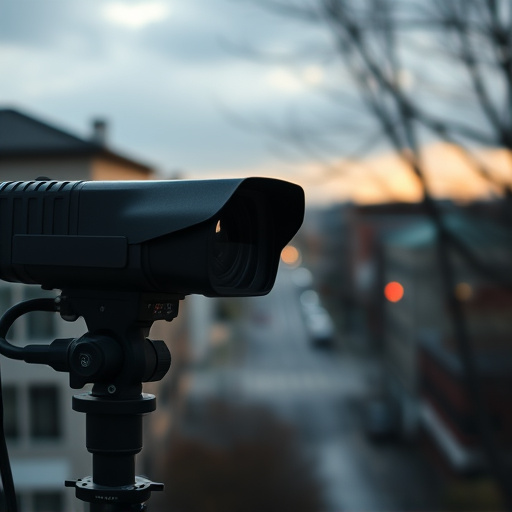Tiny cameras for home monitoring use RF signals, making them detectable with specialized equipment that scans specific bands. Regular RF checks, along with tools like thermal imaging and high-res digital cameras, are crucial to uncover these covert devices, ensuring privacy and security in homes or offices from hidden surveillance systems. Proactive measures include advanced security systems and awareness of surroundings to protect against such threats.
Uncover the invisible threat of hidden cameras with our comprehensive guide on radio frequency (RF) detection. In today’s digital age, privacy concerns are paramount, especially with the proliferation of tiny cameras for home monitoring. This guide explores RF technology, teaching you to identify and locate covert surveillance devices. Learn about specialized tools, from signal detectors to frequency scanners, enabling you to protect your personal space. By understanding potential RF signals, you can take proactive steps to safeguard your privacy.
- Understanding Radio Frequency (RF) Technology
- Identifying Potential RF Signals in Your Home
- Tools and Equipment for Detection
- Testing and Locating Hidden Cameras
- Protecting Your Privacy: Prevention Measures
Understanding Radio Frequency (RF) Technology
Radio frequency (RF) technology plays a pivotal role in detecting hidden cameras, especially tiny cameras used for home monitoring. These miniature devices operate within specific RF bands to transmit video and audio signals, making them susceptible to detection by specialized equipment. Understanding how RF works is crucial in identifying these covert surveillance tools.
RF technology relies on the transmission and reception of electromagnetic waves, which carry information like video and audio data. By employing dedicated detectors and scanners that can intercept these signals, experts can uncover hidden cameras. This process involves scanning various RF frequencies to pinpoint the unique signatures emitted by these tiny cameras, ensuring a comprehensive search for covert surveillance equipment in homes or other private spaces.
Identifying Potential RF Signals in Your Home
In today’s digital era, tiny cameras for home monitoring have become increasingly sophisticated, often employing radio frequency (RF) signals to transmit data discreetly. To detect these hidden devices, it’s crucial to be able to identify potential RF signals in your own home. Start by becoming familiar with the various types of frequencies commonly used by surveillance equipment. Many wireless devices operate on 2.4 GHz or 5 GHz bands, so checking for unusual activity within these ranges can be a good initial step.
Use specialized RF detectors or apps designed to scan for hidden camera signals. These tools can help uncover active devices transmitting data, allowing you to pinpoint potential hidden cameras. Additionally, keep an eye out for any unexplained electronic interference, such as flickering lights or distorted audio, which could indicate the presence of a radio-controlled device. Regularly checking your home’s RF environment is key to maintaining privacy and security from these concealed monitoring systems.
Tools and Equipment for Detection
Detecting hidden cameras, especially tiny cameras for home monitoring, requires specialized tools and equipment that can uncover covert surveillance devices operating via radio frequency (RF). These tools include RF detectors, which can scan a wide range of frequencies to identify signals emitted by hidden cameras. Handheld wands and fixed-location scanners are available, offering different levels of portability and sensitivity. Additionally, thermal imaging cameras play a crucial role in detecting temperature variations indicative of electronic devices, making them valuable tools for identifying miniature cameras that may be difficult to detect with RF signals alone. High-resolution digital cameras with infrared capabilities further enhance the process by allowing users to visualize hidden components and analyze patterns or anomalies suggesting the presence of surveillance equipment.
Testing and Locating Hidden Cameras
Hidden cameras, often disguised as everyday objects like smoke detectors or light bulbs, pose a significant privacy concern. Testing and locating these tiny cameras for home monitoring require specialized equipment and know-how. One effective method involves using RF (radio frequency) detection tools, which can pick up signals from hidden devices operating on specific frequencies. These tools are especially useful against tiny cameras that might be hard to detect visually.
By scanning through various frequency bands, RF detectors can pinpoint the exact location of a hidden camera’s transmission signal. This process is crucial for maintaining privacy and security in homes or offices. Regular testing with such equipment ensures that no surveillance devices operate unnoticed, fostering an environment of trust and safety.
Protecting Your Privacy: Prevention Measures
Protecting your privacy in today’s digital era is more crucial than ever, especially with the advent of tiny cameras for home monitoring that can be easily hidden and operate via radio frequency (RF). While these devices offer peace of mind, it’s essential to take proactive measures to safeguard your personal spaces. Start by conducting regular RF scans using specialized equipment to identify any suspicious signals or unknown devices in your vicinity. Install security systems with advanced detection capabilities, including infrared sensors and motion detectors, which can alert you to the presence of hidden cameras. Additionally, be mindful of your surroundings, paying attention to any unusual objects or devices within your line of sight. By combining technology, vigilance, and a proactive mindset, you can better protect your privacy from these covert surveillance devices.
In conclusion, detecting hidden cameras using radio frequency (RF) technology is a powerful method to safeguard your privacy from tiny cameras for home monitoring. By understanding RF technology, identifying potential signals, and utilizing appropriate tools, you can actively locate and disable these covert devices. Implementing prevention measures will further fortify your privacy, ensuring peace of mind in your own space. Stay vigilant and take control of your security with this comprehensive guide.
